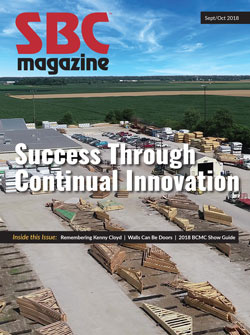Faces of the Industry: Chris Lambert
Faces of the Industry: Chris Lambert
 How’d you get into this industry?
How’d you get into this industry?
During the summers while I was in high school and college, I worked in a family-owned truss plant. After I graduated from college, a key designer left the company, and I was thrown right into the fire. Since I was familiar with the plant, falling into truss design was fairly easy - I knew what to do, and what not to do to make it easy on the production employees. I later worked myself into the sales department, and then into management. I’ve done almost every job there is in our business, but my favorite job is in sales, where you are building relationships with your customers.
What’s your favorite part about being in this industry? What could you do without?
My favorite part of this industry is the people and the relationships that I have built over the years. It is a specialized business, with a language of its own that isn’t taught in school, but everyone that’s involved seems to have a love for what we do. I also appreciate the customer relationships that I have developed, having made lifelong friends out of several customers.
I could do without aspects of the industry that [are] trying to turn our products into commodities. Lumber is a commodity but it is just one piece of what we sell. We sell an engineered product,that by no means can be consider a commodity; each job is custom-designed and highly complex. There is much greater value in the products and services that we provide than is found in your typical commoidy product line. I would also like to return to the days when face-to-face interaction was critical to your business and move way from the impersonal, digital, relationships that seem to be the norm these days .
What’s your company, market or SBCA chapter focused on right now?
Our company, as a whole, is focusing on growing the manufactured products segment of our business. We are concentrating on light commercial and regional sale sectors in our market. We are giving up the customers that merely buy on a commodity basis. We are building partnerships with builders. Commodity customers merely drive margins down. [We are] identifying high cost cutomers that also take a lot of maintenance and yield low margins and moving ourselves away from those customers and markets. By doing this, we are building stronger relationships with business savvy builders, who are engaging us more in the building concept stages and throughout the design process to see how they can build more efficiently. They understand that engagement and conversations makes the home construction process easier for them. Less RFIs is the goal.
Our SBCA chapter is focusing on education for [building] officials and new talent prospects for our industry. We continue to go to meetings with building officials to show them proper bracing techniques and different design capabilities to make sure they understand what to look for and what they don’t need to look for, which has helped a lot over the years. We continue to go into schools to help educate students on truss manufacturing and architectural design.
What challenges do you see for the industry in the future, and what should SBCA be working on now to meet those challenges?
The main challenge that we will face will be recruiting talented people into our business. We are aging out, without much bench strength, and very few people are entering the component industry because we are a specialized industry with little exposure other than to the builders we serve. Many people have no idea what a truss plant is or what we do. We need to continue to bolster our efforts in the schools and make sure kids understand that there is a career available in an industry that isn’t widely advertised. Get more exposure at the school level. [We’re] really going to run into the wall ahead if we don’t do something.
When you’re not thinking about trusses, what keeps you busy?
I am an outdoorsman to the core and live the outdoor life. It’s not just a sport, but a lifestyle for my whole family. I love hunting and fishing of any kind, particularly sporting clays in the off season and live game in the fall. My kids and I travel to Canada every fall to hunt the migratory waterfowl as they head south, a tradition that has now spanned 30 years.

